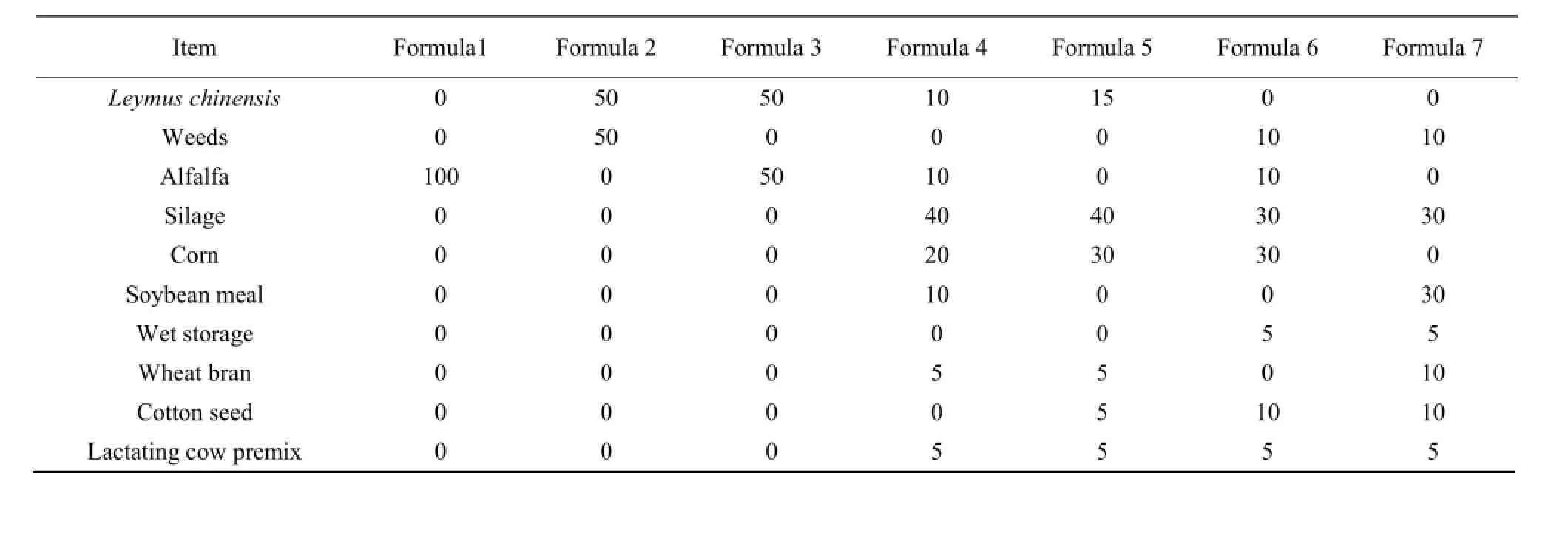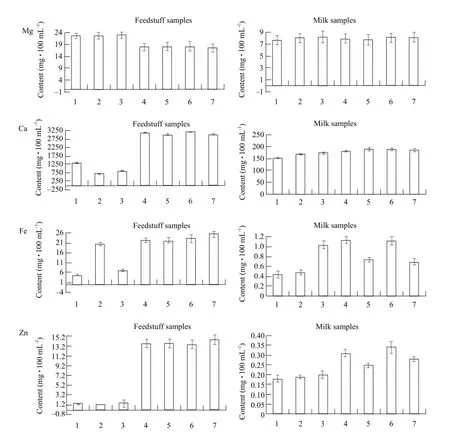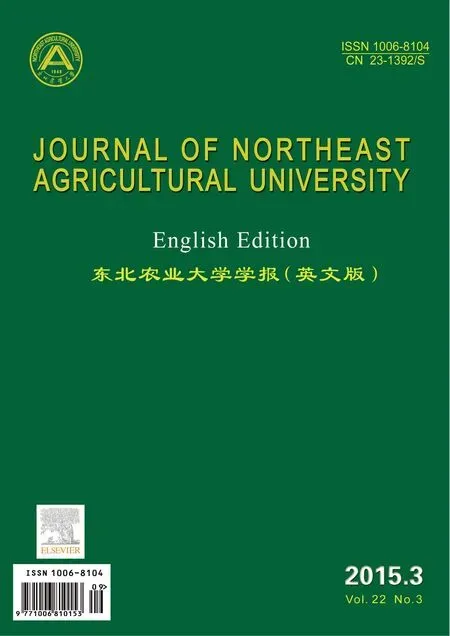Contents of Trace Metal Elements in Cow Milk Impacted by Different Feedstuffs
Song Ren-ju, Tong Hui-li, Huang Jian-guo, and Gao Xue-jun
Key Laboratory of Dairy Science of Education Ministry, Northeast Agricultural University, Harbin 150030, China
Contents of Trace Metal Elements in Cow Milk Impacted by Different Feedstuffs
Song Ren-ju, Tong Hui-li, Huang Jian-guo, and Gao Xue-jun*
Key Laboratory of Dairy Science of Education Ministry, Northeast Agricultural University, Harbin 150030, China
Feedstuff intake plays key role in impacting the yield and quality of milk. In this study, we discussed the contents of trace metal elements in cow milk impacted by different feedstuffs. We detected the contents of Pb, Cd, As, Cu, Mg, Ca, Fe and Zn in different feedstuffs and milk by atomic absorption spectrophotometry. The determinations of Pb, Cd and As contents were by graphite furnace AAS and Cu, Mg, Ca, Fe and Zn was by flame atomic absorption spectrometry. The results showed that Pb, Cd, As and Cu presented in feedstuffs, but Pb, Cd and As were lowly detected in milk samples, and Cu was not detected in milk samples. The content of Mg in concentrates was lower than that in forages. However, the content of Mg in milk from concentrate feed was higher than that in forage feed. This suggested that the utilization of Mg in concentrate feed was higher than that in forage feed. The contents of Ca and Zn were opposite to Mg, and the utilization of Ca and Zn in forage feed was higher than that in concentrate feed. There was no obviously change law of Fe in different feedstuffs and milk samples. The relationship between the contents of trace metal elements in milk to feedstuffs would provide a theoretical basis for dairy farming. It would be useful for improving the milk yield and milk quality of dairy production.
feedstuff, cow milk, trace metal element, content
Introduction
Water, milk fat, sugar, protein and vitamins are the major elements in milk and many trace elements such as Ca, Fe, Zn, Mg, Cu and P are rich in milk. Trace elements are the important components of enzyme, hormone and vitamin in living organisms, they plays very important roles in survival and metabolism of organisms. Therefore, the content of metal trace elements is an important evaluation index to evaluate the nutritional value of milk. Nevertheless, with the deterioration of environment and biological mobility, the contents of harmful heavy metal elements, such as Pb, Cd and As are possibly increasing in the milk, which are harmful to people's health. How to detect and control the contents of harmful heavy metal elements in milk has become a hot issue in recently years (Ping et al., 2012). The content of trace metal elements in milk is influenced by soil, air, water and other environmental factors in dairy cow feeding. The analysis of trace elements contents in milk will be helpful in determination the quality and origin of milk dairy products. Multi-element analysis method has been used in identificating the sources of milk, cheese and milk powder, which accuracy was more than 90% (Brescia et al., 2003; Brescia et al., 2005; Bontempo et al., 2011; Tan et al., 2015). Particularly, the intakeof feedstuffs is one of the most key factors in affecting yield and composition of milk. The addition of trace metal elements into feedstuffs can increase the milk yield and improve the milk quality (Lu et al., 2014; Hong et al., 2015). However, if the trace metal elements in feedstuffs can transform into the milk and the relationship of their contents in feedstuffs and milk still remains unclear. Therefore, in the study we intended to detect the contents of Pb, Cd, As, Cu, Mg, Ca, Fe and Zn precisely in different feedstuff formulas and their corresponding milk samples. This would be helpful to reveal the content of trace elements in milk impacted by feedstuffs. This study would help to provide theoretical basis for increasing milk yield and improving milk production of dairy production.
Materials and Methods
Animals and feedstuff materials
Healthy Holstein dairy cows in this study were similar in age, birth order, lactation stage, body weight and milk yield. Feeding experiment was carried out in a dairy farm near Harbin. All the feedstuffs and milk samples were collected in June, in order to avoid the influence of seasonal factors on the experimental results.
Ten feedstuffs were chosen in this study including leymus chinensis, weeds, alfalfa, silage (forage) and corn, soybean meal, wet storage, wheat bran, cotton seed, lactating cow premix (concentrate). Forages and concentrates were combined into different formulas, named as formula 1, formula 2, formula 3, formula 4, formula 5, formula 6, and formula 7. Five dairy cows were chosen in each experimental group with continuous feeding for 1 month, and then the milk samples were collected continuously every day for 7 days. The milk samples from one dairy cow were mixed for trace elements detection. The milk samples with corresponding formulas from 1 to 7 above were named as milk 1, milk 2, milk 3, milk 4, milk 5, milk 6, and milk 7. Ten different feedstuff samples with formula 1-7 and their corresponding milk samples 1-7 were used in the detection of Pb, Cd, As, Cu, Mg, Ca, Fe and Zn. The weight percentage of different feedstuffs in different dairy cow feed formulas is shown in Table 1. The weight percentage of different feedstuffs was calculated by diagonal method.
General reagents
Standard of Pb was purchased from the Analysis and Test Center of the National Nonferrous Metals and Electronic Materials (Beijing); standards of Cd, As and Cu were purchased from the National Standard Material Research Center (Beijing); standards of Mg, Fe, Ca and Zn were purchased from China Institute of Metrology (Beijing); Lanthanum oxide (La2O3) with high purity, palladium chloride (PdCl2) and magnesium nitrate [Mg(NO3)2] were purchased from Sinopharm Chemical Reagent Limited Corporation, (Beijing), China; other routine reagents were purchased from Comio Corporation (Tianjing), China. The water in this experiment was high purified which was produced by super pure water machine, then ultrasonicly degassed before using. Acetylene gas was used in atomic absorption spectrophotometer with high purity ≥99%, and its product standards was GB/6819-2004, China.
General instruments
Atomic absorption spectrophotometer, PerkinElmer AAnalyst 700, USA; workstation of the Atomic absorption spectrophotometer was WinLab32-AA; the microwave digestion instrument, CEM Mars 5, USA; electric heating plate, BOTONYC BHW-09C, China; electronic balance, METTLER TOLEDO XS 205, Switzerland; trace elements in super pure water machine, Asur AXLN1880-2, USA.
Preparation of standard control solutions
Pb, Cd, As, Cu, Mg, Fe, Ca, Zn were dissolved in 2% nitric acid solution to 1 000 g · mL-1, separately for standard stock solution. Then different standard stock solutions were gradually diluted to appropriate concentrations for the determination of Pb, Cd, As, Cu, Mg, Fe, Ca, Zn standard curves.

Table 1 Weight percentage of different feedstuffs in different dairy cow feed formulas
Preparation of feedstuff and milk samples
Different feedstuffs of Leymus chinensis, weeds, alfalfa, silage, corn, soybean meal, wet storage, wheat bran, cotton seed, lactating cow premix were precisely weighed at 0.5-1 g, respectively. One mL of milk samples was precisely weighed for each milk sample. Feedstuffs and milk samples were placed in a tetrafluoroethylene tank of microwave digestion instrument, and then 8 mL concentrated nitric acid and 2 mL hydrogen peroxide (volume ratio of hydrogen peroxide and water was 3 : 7) were added in the tank. All the solutions in tank were mixed and soaked overnight in the microwave digestion instrument. The process of microwave digestion is shown in Table 2. After complete digestion, the tank of microwave digestion was removed and placed in electric heating plate for heating slowly until the red brown steam had been evaporated, and then the solution in the tank was concentrated to appropriate concentration for trace element detection. Blank solutions were prepared with the same method as the above.

Table 2 Process of microwave digestion
Determination of trace metal elements in feedstuff and milk samples
The determination of Pb, Cd and As was by graphite furnace AAS, and Cu, Mg, Ca, Fe and Zn was by flame atomic absorption spectrometry. All the trace metal elements above were detected by atomic absorption spectrophotometer according to the standard procedures. The lamp wavelengths of Pb, Cd, As, Cu, Mg, Ca, Fe and Zn were 283.3 nm, 228.8 nm, 193.7 nm, 324.8 nm, 285.2 nm, 422.7 nm, 248.3 nm and 213.9 nm, respectively.
Data analysis
Sigma Plot 9.0 software was used for data statistic analysis of contents of trace metal elements infeedstuffs and milk samples. The data were shown as MEAN±SEM. The regression coefficients and correlation analysis of different trace elements between feedstuffs and milk samples were explored by SPSS 16.0 software. High value of regression coefficients meant high influence of the contents of trace metal elements in milk impacted by feedstuffs. Pearson correlation was used in the correlation analysis, and the value of significance (2-tailed)<0.05 was considered the correlation was significant and significance (2-tailed) <0.01 was considered the correlation was extremely significant.
Results
Drawing of trace metal elements standard curves
The detection of different concentrations of Pb, Cd, As, Cu, Mg, Fe, Ca, and Zn standard solutions were explored for drawing of their standard curves. The equations of linear regression and their correlation coefficient (R2) are shown in Table 3. The results showed all the trace metal elements standard curves had good linear relation, which could be used to calculate the content of trace metal elements in feedstuffs and milk samples.
Detection of contents of trace metal elements in feedstuff samples
According to the standard curve of Pb, Cd, As, Cu, Mg, Fe, Ca and Zn, the contents of these trace metal elements in different feedstuff formulas from 1 to 7 were calculated accurately, as shown in Table 4.
Detection of contents of trace metal elements in milk samples
According to the standard curve of Pb, Cd, As, Cu, Mg, Fe, Ca and Zn, these contents in different milk samples from 1 to 7 were calculated accurately, as shown in Table 4.

Table 3 Equations of linear regression and correlation coefficient (R2) of trace metal elements

Table 4 Contents of trace metal elements in different feedstuff samples
Relationship of trace element contents in feedstuffs and milk
We analyzed the relationship of trace elements contents in feedstuffs and milk according to the results of Tables 4 and 5. The statistical results are shown in Figs. 1 and 2. The results showed that Pb, Cd, As andCu presented in different feedstuff formulas of 1-7, but were very low in corresponding milk samples of 1-7 (Fig. 1). The contents of Mg, Ca, Fe and Zn in different feedstuff formulas of 1-7 and their corresponding milk samples of 1-7 both had higher concentrations compared to Pb, Cd, As and Cu (Figs. 1 and 2).

Table 5 Contents of trace metal elements in different milk samples

Fig. 1 Detection of Pb, Cd, As and Cu in feedstuffs and milk samplesContents of Pb, Cd, As and Cu in formulas 1 to 7 corresponding milk 1 to 7 are compared. Mean±SD of five replicates.
The regression coefficients and correlation analysis of different trace elements between feedstuffs and milk samples are shown in Table 6. The contents of Cd, Mg, Ca, Zn in milk had higher influence impacted by feedstuffs compared to Pb, As, and Fe. The correlation of Cd, Mg and Ca betweenfeedstuffs and milk samples appeared significantly, and the correlation of Zn between feedstuffs and milk samples appeared extremely significantly (Table 6).

Fig. 2 Detection of Mg, Ca, Fe and Zn in feedstuffs and milk samplesContents of Mg, Ca, Fe and Zn in formulas 1 to 7 corresponding milk 1 to 7 are compared. Mean±SD of five replicates.

Table 6 Regression coefficients and correlation analysis of different trace elements between feedstuffs and milk samples
Discussion
The contents of nutrients and trace elements in feedstuffs have very import influence on the growth and production performance of dairy cows. Lack or excess of some elements will affect the utilization rate of feedstuffs, resulting in decline of the production performance of dairy cows. Adjustment of feedstuff formulas and addition of active substances in feedstuffs to improve the production performance of dairy cows is one of the hot issues of livestock for a long time. Clarifing the contents of trace elements in milk impacted by feedstuffs would be helpful in dairy production. Recent years, atomic absorption spectrometry has been used in determination of trace elements in milk and feedstuffs (He et al., 2009; Gao et al., 2009; He et al., 2012; Wei et al., 2012). The contents of Pb, Cd, As, Cu, Mg, Ca, Fe and Zn were detected precisely in different feedstuff formulas and their corresponding milk samples.
The results showed that harmful metal elements Pb, Cd and As presented in different feedstuff formulas of 1-7, but they were very low in corresponding milk samples of 1-7. This indicated the harmful metal elements in feedstuffs couldn't easily been translated into the milk, which could ensure the safety of dairy production. Furthermore, the content of Cu could be detected in feedstuffs, but not detected in milk samples. There was no obviously change law of Fe in different feedstuffs and milk samples. We speculated there were other factors like environment factors which could impact the contents of Cu and Fe in milk samples.
The content of Mg in concentrates of corn, soybean meal, wet storage, wheat bran, cotton seed and lactating cow premix (formulas 4 to 7) was lower than that in forages (formulas 1 to 3). However, the content of Mg in milk from concentrate feed was higher than that in forage feed. It suggested that the utilization of Mg in concentrate feed was higher than that in forage feed. The contents of Ca and Zn were just opposite to Mg, they were lower in forages compared to concentrates, but their contents in corresponding milk samples were higher in forages feed compared to concentrate feed. This indicated the utilization of Ca and Zn in forage feed was higher than that in concentrate feed. This is consisted with the previous reports about the significant advantages of forages in improving the milk quality in dairy cows (Guo et al., 2008; Cui et al., 2012).
Conclusions
Determination and analysis of the relationship between feedstuffs and milk samples showed that Pb, Cd and As were very low in milk and their milk contents did not affect by feedstuff intake. Beneficial elements of Mg, Ca, Fe and Zn contents in milk could be affected by feedstuffs, Ca and Zn were affected mainly by forage feed whereas Mg was affected mainly by concentrate feed.
Bontempo L, Larcher R, Camin F, et al. 2011. Elemental and isotopic characterisation of typical Italian alpine cheeses. Interational Dairy Journal,21: 441-446.
Brescia M A, Caldarola V, Buccolieri G, et al. 2003. Chemometric determination of the geographical origin of cow milk using ICPOES data and isotopic ratios: a preliminary study. Italian Journal of Food Science,15: 329-336.
Brescia M A, Monfreda M, Buccolieri A, et al. 2005. Characterisation of the geographical origin of buffalo milk and Mozzarella cheese by means of analytical and spectroscopic determinations. Food Chemistry,89: 139-147.
Cui L, Li J, Yang Z F, et al. 2012. Effects of the inclusion of alfalfa and forage maize in diet on milk. Modern Journal of Animal Husbandry and Veterinary Medicine,4: 48-51.
Gao H J, Li M. 2009. Direct determination of calcium in milk by flame absorption spectrometry. Chinese Journal of Health Laboratory Technology,19(9): 2004-2005.
Guo X, Jie X L, Jiang S H, et al. 2008. Application of high trace elements of alfalfa hay in feed conversion of Holstein cows. China Herbivorous Animal,28(4): 41-43.
He L P, Wu D S. 2009. Determination of dairy cow diets of some trace elements content in raw material. Feed Angle,7: 36-38.
He L R, Li A H, Xin G S, et al. 2012. Study on the determination of mineral elements content in milk. Feed Industry,33(1): 53-55.
Hong X, Feng Y S. 2015. Study on biotransformational fresh milk of rich iron, zinc and selenium. China Dairy Cattle,1: 18-21.
Lu Y F, Zhang X Y, Li C, et al. 2014. Effects of organic mineral premix on milk yield and composition of mid-lactating Holstein cows. Feed Industry,35(21): 11-15.
Ping J F, Wu J, Ying Y B. 2012. Determination of trace heavy metals in milk using an ionic liquid and bismuth oxide nanoparticles modified carbon paste electrode. Chinese Science Bulletin,15(57): 1781-1787.
Tan K Y, Liang X L, Liao L, et al. 2015. Determination of milk powder geographical origin based on multi-element analysis. Science and Technology of Food Industry,2: 52-56.
Wei Y Q, Zhang J S, Li L H, et al. 2012. Research on content comparison of some metal elements in milk from different regions with microwave plasma torch-atomic emission spectrometry. China Dairy Industry,40(2): 50-56.
S816.72, S823
A
1006-8104(2015)-03-0054-08
Received 13 April 2015
Song Ren-ju (1981-), male, engaged in the research of lactation biology and cell biology. E-mail: 20303218@qq.com
* Corresponding author. Gao Xue-jun, professor, supervisor of Ph. D student, engaged in the research of dairy biotechnology. E-mail: gaoxj5390@ sina.com
 Journal of Northeast Agricultural University(English Edition)2015年3期
Journal of Northeast Agricultural University(English Edition)2015年3期
- Journal of Northeast Agricultural University(English Edition)的其它文章
- Design of Non-contact On-load Automatic Regulating Voltage Transformer
- Chinese Comprehensive Rural Reform: Institutional Vicissitude, Theoretic Framework and Content Structure
- Acceptability of Bush Meat as a Source of Animal Protein in Delta State, Nigeria: Implication for Extension Services
- Preparation of Mouse Embryonic Stem Cells and Cardiomyocyte Differentiation Induced with Retinoic Acid and Ascorbic Acid
- Predatory Efficacy of Cotton Inhabiting Spiders on Bemisiatabaci, Amrascadevastans Thripstabaci and Helicoverpa armigera in Laboratory Conditions
- Effect of Bacillus subtilis and Pseudomonas fluorescens on Growth of Greenhouse Tomato and Rhizosphere Microbial Community
